Meredith Martin
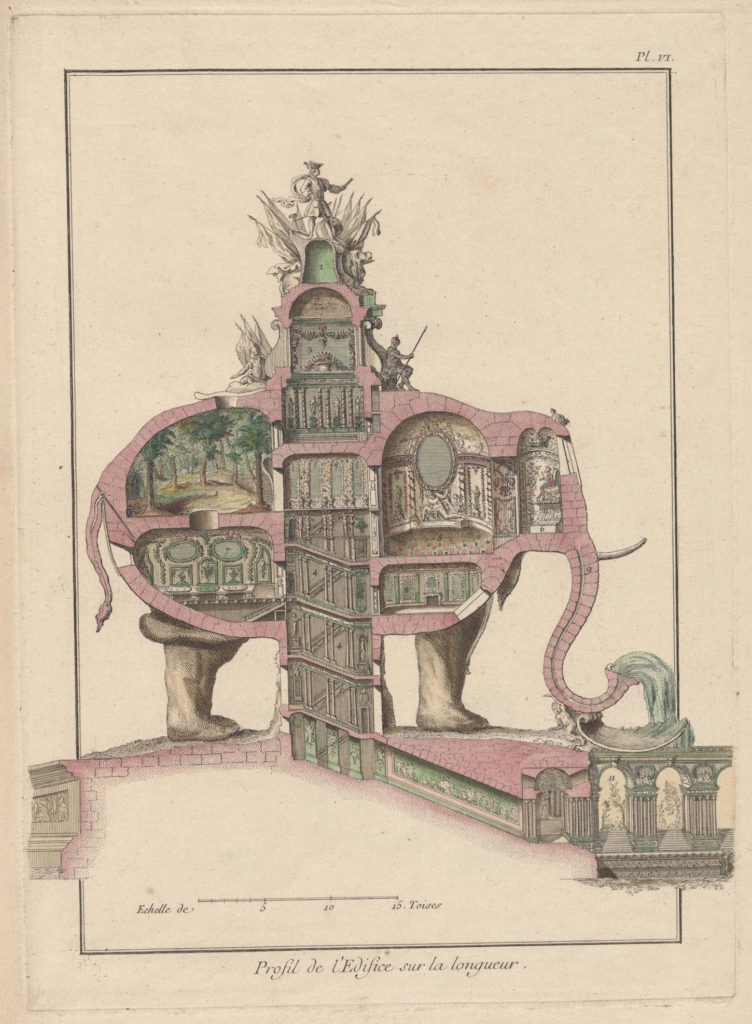
In 1748, at the end of the War of the Austrian Succession, the city of Paris decided to erect a monument to Louis XV. The project spurred an unofficial competition to design a square for the statue, resulting in scores of proposals from architects and amateurs. By far the most unusual scheme, submitted by an unknown engineer from Béziers named Charles-François Ribart (d.1807), envisioned Louis XV atop a gigantic elephant (Fig. 1). Inside the beast’s body were rooms decorated in a rococo style and outfitted with the latest conveniences. Near the tail, for instance, Ribart placed a dining room disguised as a trompe l’oeil forest, complete with a flowing stream, a rock-shaped sideboard, simulated birdsong, and a mechanical table that dropped down through the floor to allow servants to change courses without intruding on the privacy of guests. He proposed situating his monument on the elevated hill of the Étoile, where the Arc de Triomphe now stands, and surrounding it with gardens and water features that joined up with a fountain in the elephant’s trunk (Fig. 2). From here the animal was both easily visible and axially aligned with the Tuileries palace, for which it could double as a pleasure retreat or petite maison. Though clearly intended for the king, Ribart also advertised reduced versions of his elephant for anyone else “who might wish to build a structure of this type for his amusement.”[1]
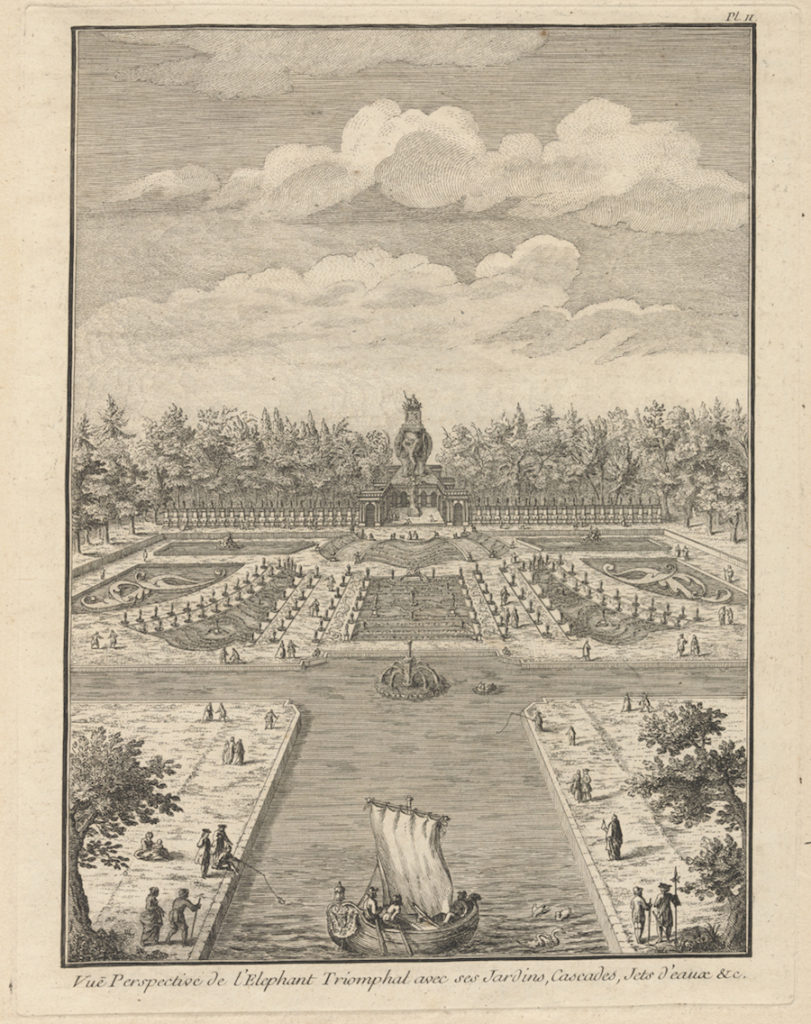
In 1758, Pierre Patte engraved and published Ribart’s project in a short text entitled Architecture singulière, l’éléphant triomphal, grand kiosque à la gloire du Roi. Praising the elephant’s “sublime” originality, Patte likened it to colossal monuments of the ancient past, including Dinocrates’s proposal to carve Mount Athos into an effigy of Alexander the Great and the Leshan Giant Buddha as described by Jesuit missionary Martino Martini. Patte’s inclusion of a Chinese example resonated with the decision to call the monument a “kiosque,” a term then associated with garden pavilions owned by Turkish potentates.[2] Perhaps Ribart had hoped to portray Louis XV not only as a French king—following a long line of Valois and Bourbon monarchs who had incorporated pachyderms into their royal propaganda[3]—but also as a powerful global sovereign, at a time when France was vying to increase its presence in the East and hold onto its Indian possessions.
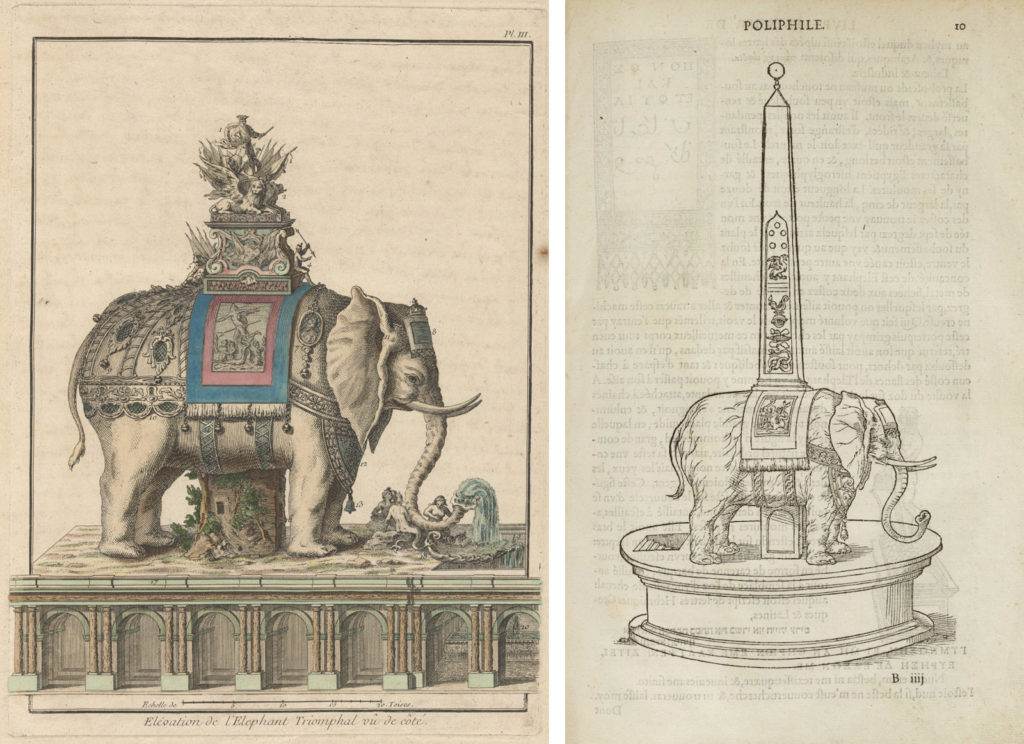
Soon after publication, Ribart’s expansive vision was attacked by journal editor and critic Élie Fréron, who wrote two articles ridiculing the monument and accusing Ribart of plagiarism: specifically of copying the engraving of an elephant from a French edition of the esoteric architectural treatise Hypnerotomachia Poliphili (Figs. 3 and 4).[4] Asking what kind of “delirious” mind could invent such “monstrous assemblages,” even going so far as “to make a dining room of [an elephant’s] ass,” Fréron sarcastically predicted that the monument would spur a whole new mode of “animal architecture,” whereby citizens would build houses shaped like the animals their personalities evoked: “wolves, oxen, pigs, donkeys, chameleons, vultures, turkeys, jays, magpies, porpoises, crocodiles, mackerels, etc. etc. etc.” Claiming it offensive for Patte to liken Ribart’s elephant to ancient masterpieces, he dismissed the animal as unworthy even of being “executed in sugar to garnish a confectioner’s boutique.”[5] Fréron’s words provoked Ribart to pen a rebuttal defending his originality and surmising that if the “malignant” Fréron himself lived in one of these animal houses, it would surely be a beastly “composite of all of these creatures.”[6]
Though the barbed exchange caused a mini-scandal at the time, it did not win Ribart any patrons, and he died—in 1807, divorced and living in a one-room bachelor pad[7]—without a building to his name. Only a few copies of Architecture singulière survive in public libraries today, some of which are exuberantly hand-colored. One such example, in the collection of Avery Library at Columbia University, contains copious annotations that appear to have been written in a late eighteenth-century hand (Fig. 5). Like Patte, their author attempts to make sense of this delightfully nonsensical building by comparing it to analogous works, including the Mausoleum of Theoderic in Ravenna; Étienne-Maurice Falconet’s equestrian statue to Peter the Great in St. Petersburg (1768-1782); and Elephanta Island in Bombay.[8] He or she transcribes descriptions of these monuments verbatim (and without acknowledgment) from contemporaneous sources, including Fréron’s own journal L’Année littéraire, which had featured a short report on Elephanta in the same issue as the attack on Ribart.[9] Fréron’s critique is also quoted at length.
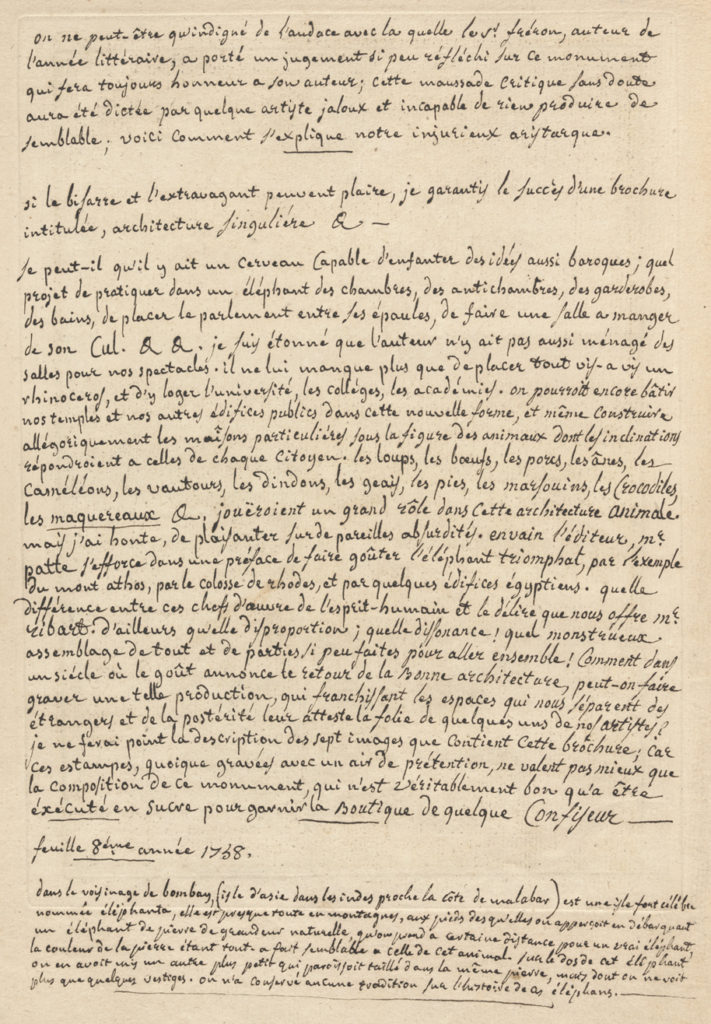
Over the past year I have developed a mild obsession with Ribart’s monument and with Avery’s copy of his treatise. I have spent a lot of time trying to figure out who could have annotated the text, consulting both a paleographer and a forensic handwriting expert. I had almost abandoned hope until last month, when I stumbled upon a series of letters that mention Ribart’s project at the Bibliothèque nationale de France [BnF]. Tucked inside an unrelated volume in the Cabinet des estampes, the letters appear to have been part of the cache of more than 800 drawings, letters, manuscripts, and related materials by the visionary architect Jean-Jacques Lequeu (1757-1826), who donated them to the library in 1825. Lequeu—coincidentally the subject of an exhibition at the Petit Palais in Paris (Dec 18, 2018 – Mar 17, 2019)—was, like Ribart, a paper architect who tried for years but ultimately failed to attract clients; he too died having built almost nothing. His bequest to the BnF is, in fact, the sole reason we remember him today.
All but one of the letters I found, which must have gotten separated from the larger bequest at some point, are written by Lequeu to Dominique-Vivant Denon (1747-1825), best known as Napoleon’s first director of the Louvre and a key member of his Egyptian campaign. Yet like Lequeu and Ribart, Denon’s life spanned multiple political regimes, and prior to the Revolution he rose through the ranks of the Bourbon monarchy first as a keeper of Madame de Pompadour’s medals and gems, and later as a diplomat to Sweden, Switzerland, Russia and Italy. In the midst of all these travels, Denon found time to write and publish (anonymously) an erotic novel, Point de Lendemain (1777), and he was also an accomplished engraver specializing in portraits, antiquities, and pornographic subjects, among them a monumental phallus (Fig. 6).
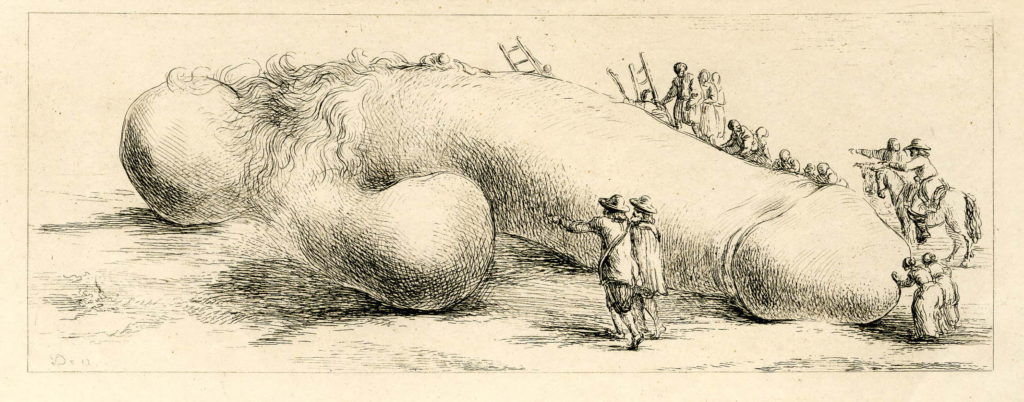
Lequeu seems to have started writing to Denon in 1787, soon after the latter returned from Italy and became a member of the French Royal Academy of Painting and Sculpture. He continued to send Denon letters, sometimes including drawings, until 1814, when Denon finally responded by returning all of Lequeu’s letters along with a single, terse reply. Though Lequeu’s main motivation was to see if Denon could help him find employment—he made similar requests to the Comte d’Angiviller, Louis XVI’s arts administrator, in 1788, and to the Minister of the Interior around 1800[10]—he also appears to have viewed Denon as a kindred spirit, and hoped to strike up a friendship with him. Yet over time Lequeu became increasingly frustrated with Denon’s silence, and more paranoid in general.
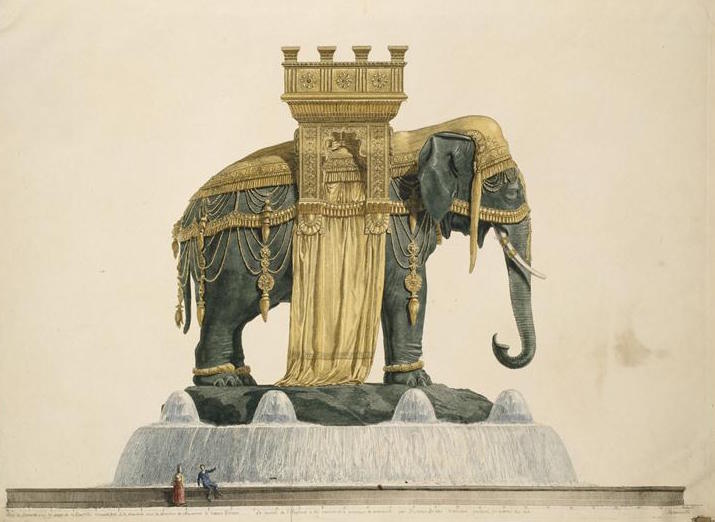
This mostly one-sided epistolary exchange is fascinating for many reasons, one of which is that it implies Lequeu authored the Avery annotations. More importantly, it posits a link between Ribart’s proposal and the giant elephant monument built for Napoleon on the Bastille beginning in 1810 (Fig. 7). Denon spearheaded the Bastille scheme, which was supposed to result in a majestic bronze elephant, though changing political fortunes meant that only a cut-rate plaster pachyderm was installed on the site instead. Completed in 1814, this plaster elephant surprisingly stayed in place for more than three decades, slowly disintegrating, until it was finally torn down in 1846.[11]
In what follows, I offer an annotated translation of two letters in which Lequeu discusses Ribart’s elephant and its Bastille offspring, as well as Denon’s response.
January 23, 1788
Letter from M. Lequeu, Architect, born in Rouen, former student of Jacques-Germain Soufflot, addressed to his excellency the Chevalier de Non,[12] Diplomat to the King, and Member of the Royal Academy of Painting and Sculpture
Monsieur,
In my last letter I told you I was working on a manual for engravers,[13] and when I am finished I would be honored to send you a copy so that you might show it to your colleagues at the Academy. Though I am above all an architect I work in many different capacities, and like you I have many interests. Forgive me if I am being too familiar, but I heard you were the author of the novel Point de Lendemain, which I read with considerable pleasure, admiring above all its beautiful and very accurate descriptions of architecture and gardens. It inspired me to make a drawing of a young woman that I include with this letter, which you should view only in the company of other men.
In Point de Lendemain you describe Mme de T—’s château and gardens “resting against a mountainside and descending in terraces to the banks of the Seine.” It made me think of another drawing I have made, after the Songe de Poliphile [the French title of the Hypnerotomachia Poliphili], depicting the “Île d’amour” where Poliphilus and his beloved travel at the beginning of their journey. I have placed a small temple to Cythera at the top of this island, surrounded by fertile hills, with terraced gardens that spill down to fountains and water below (Fig. 8). Many years ago I acquired a copy of Colonna’s treatise[14] from a bookseller along the Quay, and since then it has inspired several of my designs. Perhaps it served the same purpose for you, as it has for so many other architects and men of letters?
You may remember that years ago the Songe de Poliphile was the subject of a scandal between the odious Fréron, editor of the Année littéraire and enemy of Voltaire, and M. Ribart, author of a monument to King Louis XV in the form of a colossal elephant des Indes. Fréron accused Ribart of plagiarizing the engraving of an elephant from Colonna’s treatise. If you look at the two designs together (Figs. 3 and 4), in fact there does seem to be a close resemblance, but if that is plagiarism, then are we not all guilty? Ribart has only used this source to give birth to a new idea that is entirely the product of his own genius. He represents our illustrious former sovereign Louis XV as Tippo-Saïb,[15] returning triumphantly from battle, in the same manner that our French kings François I and Henri II used to […] elephants in the decoration of their palaces and ceremonial processions. The author of an account of Henri II’s entry into Rouen in 1550 tells us that during that procession there were artificial elephants “so close to real elephants that even those who had seen live ones in Africa would not have judged them imitation elephants, if they had seen them.”[16] It is said that the designer of the Rouen entry, Jean Goujon, was the same one who made the first woodcuts of the Songe de Poliphile in France.
It’s true that the exterior of Ribart’s monument is a little outdated. Ribart puts chained slaves at the feet of the king, even though M. Voltaire had already criticized this practice in his Siècle de Louis XIV.[17] But the rooms inside his elephant are like something out of a fairy tale, and their decoration is thoroughly in le goût moderne. M. Patte compares it to ancient statues such as those that the great Dinocrates conceived for Alexander the Great, as well as a Chinese Buddha, but it also resembles the stone elephants on the celebrated island of Elephanta as well as wonderful monuments from our own times, like the bronze statue of Peter I on horseback built for the Empress of Russia. Ribart was unfairly attacked by M. Fréron, who said that the elephant would give rise to a new type of animal architecture, which is actually the only interesting idea he ever had (Fig. 9). It is a pity that men without imagination condemn those who have it, and that the public cannot tell the difference.
Monsieur I am, with consideration, your very humble and very obedient servant,
Jean-Jacques Lequeu
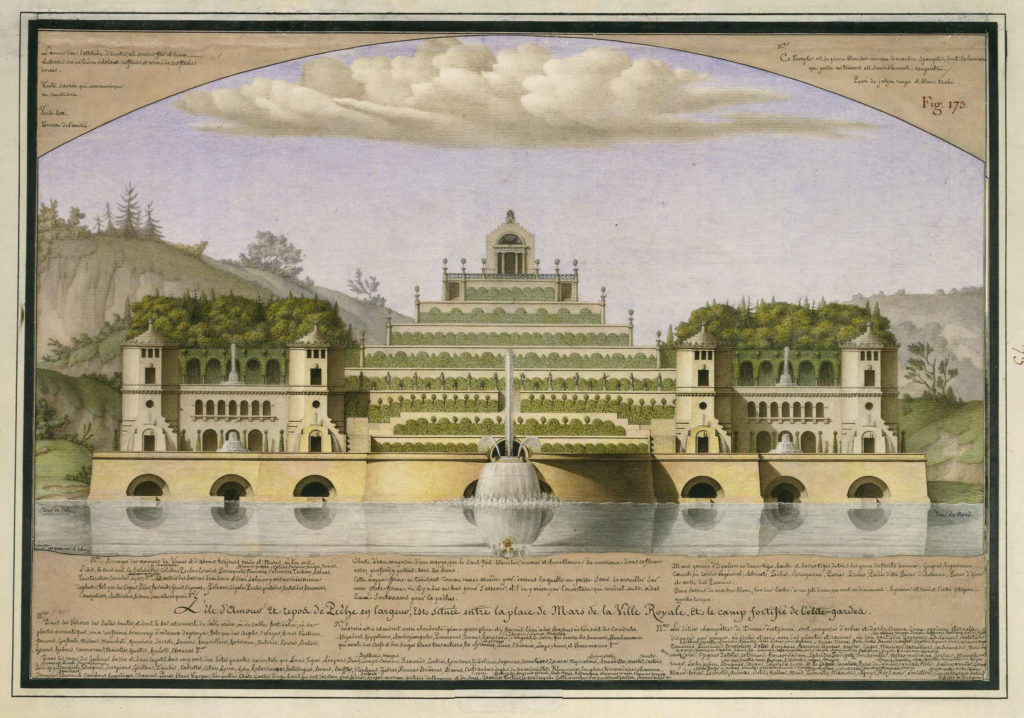
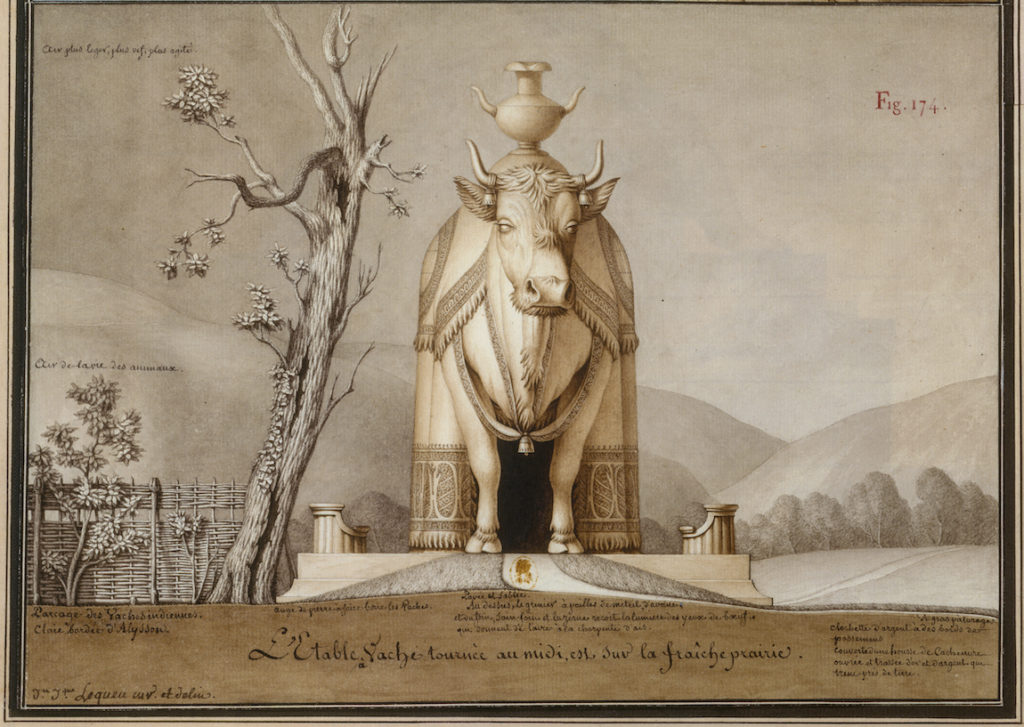
October 5, 1814
To Baron Denon, Director general of the Musée royal des arts[18]
Monsieur,
I have just returned from the Salon where I saw M. Alavoine’s design for the elephant monument and fountain that is being built on the place de la Bastille. Of course I have known for a long time that the Emperor, before he left France, had planned to create a monument of this type under your direction, and like the rest of the world I have seen the plaster model by M. Bridan. But until I viewed the drawing today I did not realize how closely its conception recalls the earlier monument in the form of an elephant by M. Ribart, which I told you about in a letter many years ago. I would think this […] would finally lead you to respond, if only to thank me for supplying you with the seed[19] for an idea to which you are now giving birth. Or at least you could have asked me to take part in the construction. In my capacity as an architect I have conceived many varied monuments over the years, beginning with a statue honoring our former sovereign Louis XVI in 1777. During the Revolution, I proposed several monuments, temples and buildings dedicated to the Liberty and Equality of our citizens, as well as to the bounties of Nature. Even now I am continuing to work on the design of a palace for the Emperor Napoleon, in case he should return, with splendid and ornate interiors; I enclose one of my designs for an audience room that I think would please him.[20] Like you, Monsieur, I am a chameleon, and I could be very useful to you and to the Emperor, especially in these difficult times.
your very humble and very obedient servant,
Jean-Jacques Lequeu
October 11, 1814
To Jean-Jacques Lequeu, Architect
Monsieur,
I am returning the letters and drawings you have been sending me over the years. Although they are clearly the product of an extremely fertile imagination, I have no use for them, and I think they would be better off in your hands. Perhaps you might think about giving some of your drawings and instruction manuals to the Bibliothèque royale, so that future architects, engineers and draftsmen could be inspired by your designs.
respectfully yours,
Baron Vivant Denon
Author’s Postscript
Now that you have followed me to the end, reader, I must confess that I have fabricated this correspondence. As far as I am aware, no letters exist between Lequeu and Denon, at the BnF or anywhere else. Furthermore Lequeu’s handwriting does not match the annotations on the Avery treatise, even though they, like Ribart’s elephant, are wholly consistent with his interests.[21]
I felt compelled to write these parafictional letters for several reasons. First, the epistolary genre is the quintessential art form of the eighteenth century, and was often used by architects wanting to appeal to a broader public.[22] Second, it was also common for early modern authors to forge letters—Montesquieu’s Persian Letters (1721) is perhaps the best-known example—or to claim to have “discovered” documents in the archives, as when the Abbé Terrasson attempted to pass off his popular novel Séthos (1731) as the translation of an ancient Greek manuscript he had found “in the library of a foreign nation, extremely jealous of this type of treasure.”[23] Third, Lequeu’s enigmatic oeuvre has, as Denon predicted, inspired any number of architects and scholars to want to exercise creative license and make stuff up about him—most notoriously the theory that he is a semi-fictional creation of Marcel Duchamp’s.[24]
Unlike Lequeu, the archive is virtually silent on Ribart, so much so that historians and library catalogues can’t even agree on who he is or what to call him.[25] This silence, combined with the meager description of his belongings in the posthumous inventory I found – so incongruous with the imagined plentitude of his elephant palace – spurred me to try to fill that melancholy gap. I wanted to invent for Ribart a historical fiction that one might liken to a museum period room – a fabricated “assemblage” that nonetheless aims to channel and convey something meaningful about the past, however futile or illusory that attempt may be.
Finally I wanted to place Ribart and his elephant in the same pantheon of paper architecture that, perhaps because it exists solely on paper, continues to stimulate the imagination and encourage new experiments. This short essay is a minor contribution to his monument’s “delirious” legacy, which includes not only the Bastille elephant but also Coney Island’s Elephant Hotel (1885-1896), Venturi and Scott Brown’s “Big Duck” from Learning from Las Vegas (1972), and the giant animatronic elephant created by La Machine in Nantes, who chased down and sprayed me and a colleague when we paid her a visit in 2017 (Fig. 10).
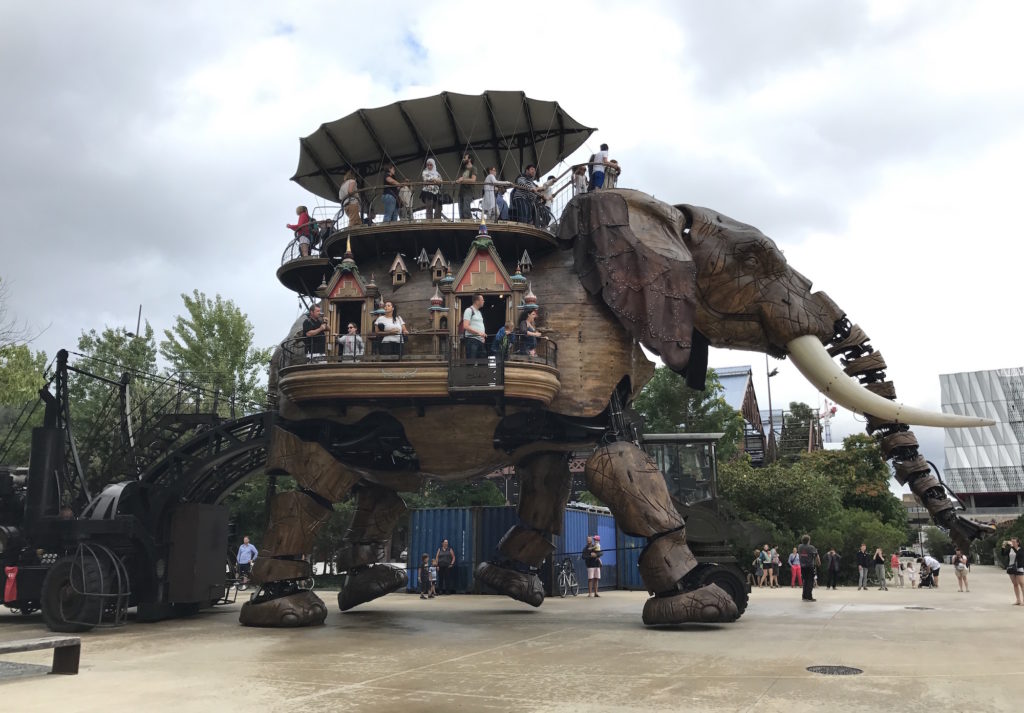
For help with this project I would like to thank Basile Baudez, Katie Hornstein, Hannah Williams and especially Noémie Etienne. In art history, as in life, it is good to have partners in crime.
Meredith Martin is Associate Professor of Art History at New York University and the Institute of Fine Arts, and a founding editor of Journal18
[1] Charles-François Ribart, Architecture singulière, l’éléphant triomphal, grand kiosque à la gloire du Roi (Paris: Chez P. Patte, 1758), 8. Although Ribart does not compare his design to a petite maison, it’s interesting that his proposal was published the same year as Jean-François de Bastide’s “La petite maison” (Le Nouveau spectateur 2 (1758): 361-412) and shares many similarities with the interiors described in that text.
[2] The 1762 (4th) edition of the Dictionnaire de l’académie française defines “kiosque” as “mot empruté du Turc, qui se dit de certains pavillons qui sont dans des jardins sur des terrasses.” See also Nebahat Avcioglu, Turquerie and the Politics of Representation, 1728-1876 (Farnham: Ashgate, 2011), part I.
[3] Charles Le Brun’s Alexander Entering Babylon, or The Triumph of Alexander (1665), for instance, shows Alexander entering Babylon on an elephant-drawn chariot and was intended (like Le Brun’s entire Alexander cycle) to pay homage to Louis XIV. Musée du Louvre, Inv. 2898. On the use of elephant propaganda and décor by the Valois kings, as well as other medieval and early modern rulers, see William S. Heckscher, “Bernini’s Elephant and Obelisk,” The Art Bulletin 29:3 (September 1947), 155-182.
[4] Fréron accuses Ribart of plagiarizing the 1600 French edition, but since the author of that version (Béroalde de Verville) reuses the famous Jean Goujon woodcuts from the 1561 French edition by Jean Martin, I have illustrated that one instead.
[5] Élie Fréron, “Architecture singulière” and “Plagiat,” L’Année littéraire 8 (1758), 154-160; 328-335.
[6] “Lettre de M. Ribart, auteur de l’éléphant triomphal,” (n.d.), 7.
[7] “Inventaire après décès de Charles-François Ribart [11 July 1807],” Archives nationales de France, notarial archives of Auguste Thion de la Chaume, étude XXXV, 1016.
[8] Ann Blair has compared the early modern “stockpiling” of annotations to a broader culture of collecting that included the formation of cabinets of curiosities, an analogy that seems apt here. See Blair, “The Rise of Note-Taking in Early Modern Europe,” Intellectual History Review 20:3 (2010), 310.
[9] Fréron, Lettre XII, “Voyage aux Indes Orientales,” in L’Année littéraire 8 (1758), 265. The description of Falconet’s statue is lifted from Affiches d’Orléans, March 30, 1770; that of Theodoric’s mausoleum from Amédée Frezier, La théorie et la pratique de la coupe des pierres et des bois… (Paris: C.A. Jombert, 1738), vol. 2, 30. I found these sources by searching for random phrases in Google.
[10] For Lequeu’s letters to the Comte d’Angiviller see Archives nationales de France, O/1/1267, fol. 67, 98 and 99. For his employment letter to the Minister of the Interior, see Bibliothèque nationale de France, Département des estampes, Réserve HA-80 (1)-FOL.
[11] Matthieu Beauhaire, Mathilde Béjanin, and Hubert Naudeix, L’éléphant de Napoléon (Arles: Honoré Clair Editions, 2014).
[12] Born to a family of the “petite noblesse,” Denon was known before the Revolution as the “Chevalier de Non,” but afterwards, like many members of the nobility, he dropped the “de.” Napoleon made him a Baron in 1812, which is why Lequeu addresses him this way in 1814.
[13] Lequeu’s Précis méthodique pour apprendre à graver le lavis à l’eau-forte (1789).
[14] Francesco Colonna was (and is) the presumed author of the Hypnerotomachia Poliphili. Lequeu owned a copy of this book at the time of his death; see Werner Szambien, “L’Inventaire après décès de Jean-Jacques Lequeu,” Revue de l’art 90 (1990), 107.
[15] Lequeu refers here to Tipu Sultan of Mysore, who sent a diplomatic embassy to Versailles in 1788 to ask Louis XVI to help him fight the British in India. Though his ambassadors did not arrive in France until June 1788, their impending visit had been the talk of the town for months. The October 23, 1787 edition of the Correspondance littéraire, for instance, noted how “On attend incessamment deux ambassadeurs de Tippo-Saïb (193).”
[16] C’est la déduction du somptueux ordre, plaisantz spectacles et magnifiques theatres dresses et exhibes, par les citoiens de Rouen … (Rouen: Robert et Jehan dictz Dugord, 1551).
[17] François-Marie Arouet de Voltaire, Le siècle de Louis XIV [1751] (Frankfurt: Knoch & Eslinger, 1753), vol. 2, 364: “D’ailleurs c’est un ancien usage des sculpteurs de mettre des esclaves aux pieds des statues des rois.”
[18] During this period, when Napoleon was exiled to Elba and Louis XVIII was on the throne, the Musée Napoleon (now the Louvre) was renamed the Musée royal des arts.
[19] Lequeu literally uses the French word sperme (sperm) here. He was fascinated with theories of human generation and made several drawings related to this subject over the years. At the same time, his metaphor recalls the Renaissance architect Filarete’s famous description of architecture as akin to biological reproduction, with the patron as a father who helps conceive the project and the architect as a mother who carries it and then gives birth to the final form. See Filarete’s Treatise on Architecture, trans. John Spencer (New Haven: Yale University Press, 1965), 15.
[20] This must be Lequeu’s Interior decoration of a palace audience hall, which is ornamented with Napoleonic emblems of eagles and bees and included within Architecture civile (pl. 50), a manual of architectural drawings that was part of his BnF bequest.
[21] The curators of the Petit Palais show Jean-Jacques Lequeu (1757-1826). Bâtisseur des fantasmes seem to agree on the affinity, since they included a copy of Ribart’s treatise in the exhibition.
[22] Richard Cleary, “Romancing the Tome; Or an Academician’s Pursuit of a Popular Audience in 18th-Century France,” Journal of the Society of Architectural Historians 48:2 (June 1989), 139-149. Cleary gives as examples Michel Frémin’s Mémoires critiques d’architecture (1702) and L’homme du monde éclairé par les arts (1774), a collaboration between Jean-François de Bastide and Jacques-François Blondel.
[23] Jean Terrasson, Séthos, histoire, or vie tirée des monumens anecdotes de l’ancienne Égypte, traduite d’un manuscrit grec (Paris: Chez Jacques Guérin, 1731), preface. Lequeu quotes Séthos (without acknowledgment) in his drawing Perpendicular section of the underground of the gothic house, in Architecture civile, pl. 61.
[24] Philippe Duboy, Lequeu: An Architectural Enigma (Cambridge: MIT Press, 1987).
[25] Most scholars refer to him as “Charles-François Ribart,” or “Charles-François Ribart de Chamoust,” and assume he was the same person who later wrote the treatiseL’ordre François trouvé dans la nature (Paris: Nyon l’aîné, 1783). Jean Marie Pérouse de Montclos, however, claims that these are two different people (“Le Sixième Ordre de Architecture, ou la Pratique des Ordres Suivant les Nations,” Journal of the Society of Architectural Historians 36:4 (December 1977), 233, n. 62), and in The Oxford Dictionary of Architecture James Stevens Curl and Susan Wilson say his first name was probably François-Joseph rather than Charles-François, “who was author of some works on finance” (3rd ed., 2015, www.oxfordreference.com; accessed 13 February 2019). The BnF’s online catalogue (www.catalogue.bnf.fr; accessed 13 February 2019) mixes up these names, attributing both Ribart’s rebuttal to Fréron (see n. 6) and a Mémoire sur la pénure des finances, par un antifinancier (1795) to “François-Joseph.” Clearly more sleuthing is needed.
Cite this note as: Meredith Martin, “Monstrous Assemblage: Ribart’s Elephant Monument to Louis XV,” Journal18, Issue 7 Animals (Spring 2019), https://www.journal18.org/3570.
Licence: CC BY-NC
Journal18 is published under a Creative Commons CC BY-NC International 4.0 license. Use of any content published in Journal18 must be for non-commercial purposes and appropriate credit must be given to the author of the content. Details for appropriate citation appear above.
